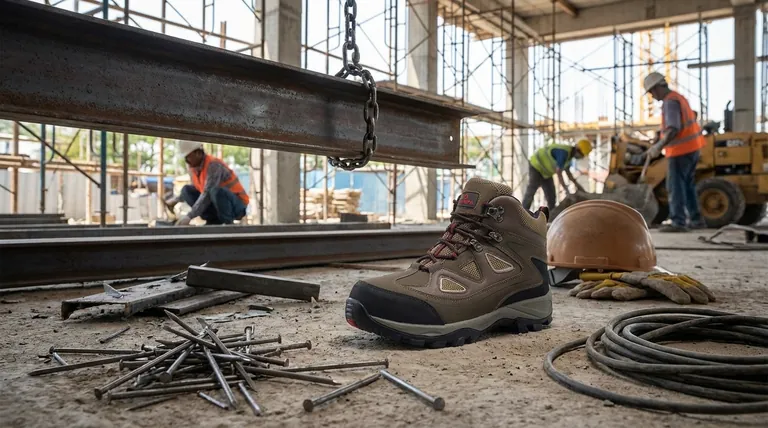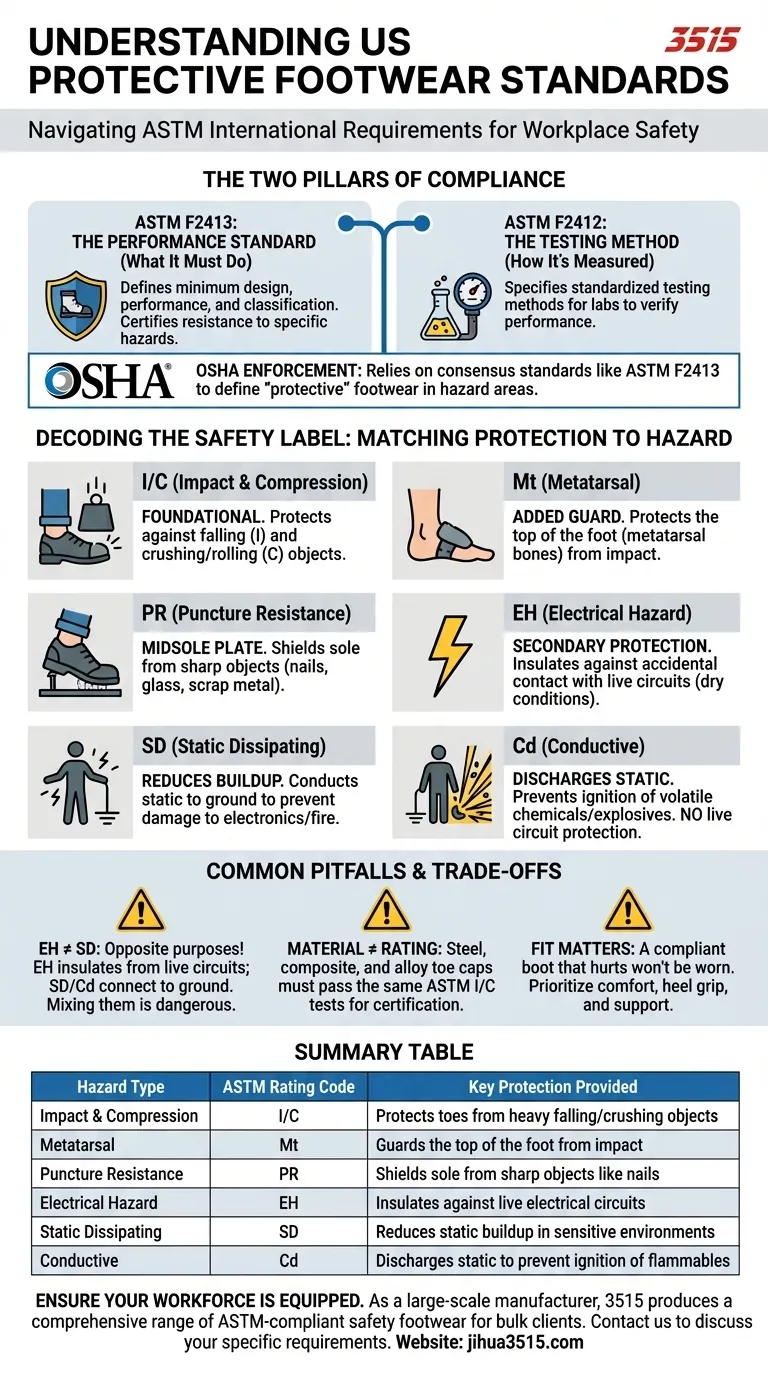In the United States, all legitimate protective footwear must meet the specifications of two core standards from ASTM International: ASTM F2413 and ASTM F2412. ASTM F2413 defines the minimum performance requirements for safety features like impact resistance and puncture protection. ASTM F2412 specifies the standard test methods that laboratories must use to verify the footwear meets those performance requirements.
The key to understanding footwear safety is realizing that the standard isn't a single certification. It is a system of specific ratings for distinct hazards. True compliance comes from performing a hazard assessment of your worksite and selecting footwear with the exact ratings that mitigate those specific risks.

The Two Pillars of Footwear Compliance
To ensure footwear is truly protective, the industry relies on a clear system of performance requirements and standardized testing. This is governed by ASTM International and enforced by agencies like the Occupational Safety and Health Administration (OSHA).
ASTM F2413: The Performance Standard
This is the most important standard for the end-user. It outlines the minimum requirements for design, performance, testing, and classification. It is the standard that certifies a boot is resistant to specific hazards.
ASTM F2412: The Testing Method
This standard is for the testing laboratories. It describes in detail how to test footwear for resistance to impact, compression, and other dangers. It ensures that a boot tested in one lab is measured by the same yardstick as a boot tested in another.
The Role of OSHA
OSHA requires employers to ensure their employees wear protective footwear when working in areas with known foot hazards. OSHA does not write the footwear standards itself but instead relies on and enforces consensus standards like ASTM F2413 to define what constitutes "protective."
Decoding the Safety Label: Matching Protection to the Hazard
An ASTM-compliant boot will have a label (typically on the inside of the tongue) that specifies which sections of the standard it meets. Understanding these codes is essential for selecting the right protection.
Impact (I) and Compression (C) Resistance
These are the foundational ratings for any safety-toe boot. They signify that the toe cap has been tested to protect against heavy falling objects (Impact) and crushing or rolling objects (Compression). All safety-toe footwear must meet these standards, regardless of whether the toe cap is made of steel, composite, or alloy.
Metatarsal (Mt) Protection
This rating indicates the footwear includes an added guard that protects the top of the foot (the metatarsal bones) from impact. This is crucial in environments with a high risk of heavy objects dropping directly onto the foot.
Puncture Resistance (PR)
Footwear with a PR rating has a puncture-resistant plate built into the midsole. This is designed to protect the sole of the foot from being pierced by sharp objects like nails, scrap metal, or glass.
Electrical Hazard (EH)
EH-rated footwear is manufactured with non-conductive, electrical shock-resistant soles and heels. It is intended to provide a secondary source of protection against accidental contact with live electrical circuits.
Static Dissipating (SD)
This type of footwear is designed to reduce the buildup of excess static electricity by conducting it from the body to the ground. It is used in environments where static discharge could damage sensitive electronic equipment or cause a fire or explosion.
Conductive (Cd)
Conductive footwear is designed to discharge static electricity from the body into the ground to protect against the risk of igniting volatile chemicals or explosives. It offers no protection against live electrical circuits and should never be confused with EH-rated boots.
Understanding the Trade-offs and Common Pitfalls
Choosing the right boot goes beyond simply finding one with an ASTM label. Misunderstanding the details can lead to non-compliance or, worse, a serious injury.
Pitfall 1: Confusing "EH" and "SD"
These two ratings are for opposite purposes. EH footwear insulates you from electricity. SD and Cd footwear connect you to the ground to discharge static. Using an SD boot while working with live circuits is extremely dangerous.
Pitfall 2: Believing Material Dictates Compliance
The material of the safety toe—whether steel, aluminum, or composite—does not determine its safety rating. All materials must pass the exact same ASTM tests for Impact (I) and Compression (C) to be certified. The choice is about weight, thermal conductivity, and whether you need to pass through metal detectors.
Pitfall 3: Ignoring Fit and Support
A compliant boot that is painful or ill-fitting will not be worn properly, defeating its purpose. True safety footwear must provide a firm heel grip, allow toes to move freely, and include shock-absorbing insoles for workers who stand on hard surfaces.
How to Select the Right Protective Footwear
Your choice must be based on a risk assessment of your specific work environment. Use the standards to find the right tool for the job.
- If your primary focus is construction or heavy manufacturing: Prioritize footwear with I, C, and PR ratings, and consider Mt protection if there is a high risk of falling objects.
- If your primary focus is working as an electrician: You must select footwear with a clear EH rating and ensure it is kept clean and dry to maintain its insulating properties.
- If your primary focus is electronics assembly or handling flammable materials: Choose SD-rated footwear to safely dissipate static electricity and prevent damage or ignition.
- If your primary focus is general site safety and comfort: Ensure any selected boot has the minimum I/C rating and pay close attention to proper fit, support, and shock absorption to ensure consistent use.
Understanding these standards empowers you to move beyond basic compliance and build a truly effective foot protection program.
Summary Table:
| Hazard Type | ASTM Rating Code | Key Protection Provided |
|---|---|---|
| Impact & Compression | I/C | Protects toes from heavy falling/crushing objects |
| Metatarsal | Mt | Guards the top of the foot from impact |
| Puncture Resistance | PR | Shields sole from sharp objects like nails |
| Electrical Hazard | EH | Insulates against live electrical circuits |
| Static Dissipating | SD | Reduces static buildup in sensitive environments |
| Conductive | Cd | Discharges static to prevent ignition of flammables |
Ensure your workforce is equipped with the right protective footwear. As a large-scale manufacturer, 3515 produces a comprehensive range of ASTM-compliant safety shoes and boots for distributors, brand owners, and bulk clients. Our production capabilities encompass all types of protective footwear, ensuring you get the exact ratings needed for your specific workplace hazards. Contact us today to discuss your requirements and benefit from our expertise in safety footwear manufacturing.
Visual Guide

Related Products
- Safety Footwear Wholesale Manufacturer for Custom OEM/ODM Production
- Advanced KPU Athletic Safety Shoe with Steel Toe Cap Anti-Slip Rotary Lacing System
- Wholesale Premium Waterproof Nubuck Safety Shoes Boots
- Puncture-Resistant Velcro Safety Boots for Wholesale & Custom Manufacturing
- Premium Flame-Retardant Waterproof Safety Boots and Shoes
People Also Ask
- Is it normal to wear shoes in the house? A Guide to Hygiene, Comfort & Culture
- What do heavy duty boots do? Protect Your Feet in Demanding Work Environments
- What are the cultural perspectives on wearing shoes in the house? A Guide to Home Etiquette & Hygiene
- How long can you wear safety boots? The Lifespan is Determined by Wear, Not Time
- Is safety-toe as good as steel toe? Choose the Right Protection for Your Job



















